|
This time the trip was to Argentina. After a pleasant flight via Madrid we arrived at the capital Buenos Aires.
At the airport a taxi was already waiting for us which took us to the hotel. As we had arrived early we immediately
set off to explore the city on foot. First we pampered ourselves with a juicy steak and a small bottle of
Argentinian red wine. Then three days started in which we walked endelssly.
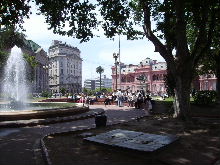 On the first day we visited the city center in which stands the "Casa Rosada", the Rosa House which is seat of the
president. In front of the Casa Rosada is the Plaza de Mayo on which the mothers of the "disappeared" still gather
to demand an answer on the fate of their children during the dictatorship. The cathedral is also here. A must is the
Avenida 9 de Julio with its striking obelisk and which is said to be the broadest street on the world.
On the first day we visited the city center in which stands the "Casa Rosada", the Rosa House which is seat of the
president. In front of the Casa Rosada is the Plaza de Mayo on which the mothers of the "disappeared" still gather
to demand an answer on the fate of their children during the dictatorship. The cathedral is also here. A must is the
Avenida 9 de Julio with its striking obelisk and which is said to be the broadest street on the world.
On the second day we strolled through the waterfront of Puerto Madero. This district is evolving rapidly to a quarter
of the affluent who live in luxurious appartments in skyscrapers. Chic cafés and restaurants surround the former port
basins. The old cereal storehouses were converted to appartments. Then we walked through the districts of Retiro and
Recoleta which also are upper-class. The pedestrian zone on Calle Florida ends at the beautiful Plaza San Martín. Buenos
Aires has a very assorted architecture, much of it in French style. It has a feeling of Paris.
The many Latin Americans from such countries as Brazil and Chile are not easily recognizable.
At the evening we were invited to a milonga. This is an event in which tango is sung. Those were no professional singers
but older people who had gathered to escape solitude and experience some pleasant hours. In tango the text is more
important than melody and rhythm and also very melancholical.
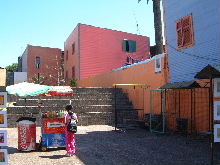 On our last day in Buenos Aires we went to La Boca. There, in the midst of a worker district, has emerged a tourist
attraction. The colorful painted houses are no longer original. Nearby is the stadium in which the Boca Juniors play, one
of the best Argentinian soccer teams.
On our last day in Buenos Aires we went to La Boca. There, in the midst of a worker district, has emerged a tourist
attraction. The colorful painted houses are no longer original. Nearby is the stadium in which the Boca Juniors play, one
of the best Argentinian soccer teams.
Football - a national passion. The news of the country are made up of a few political themes which are played up, of the
most recent murders and of thorough football news.
After that we endelssly walked through the district of Palermo in which the middle class lives. Of architectural interest
here ist the "Palacio de las Aguas Corrientes", the water works, a beautiful building which is not broadly known.
On the fourth day we picked up our rental car and left towards the north. First we drove along the Uruguay River which
is the border to the country with the same name. We spent the night in Concepción. Nearby we visited the "Palacio San José"
in which Justo José de Urquiza, Argentina's first constitutional president, lived. He was murdered here in 1870. Then we
drove to El Palmar National Park where the yatay palm is protected.
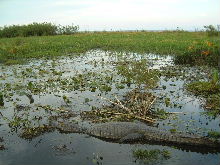 Through Curuzú Cuatiá we reached one of the highlights of our trip, Esteros del Iberá National Park. After 120 km gravel
road we reached the town of Colonia Pellegrini. In the afternoon we went by boat to the lagoon with all its exhuberant
species. There yacarés (caimans), capybaras and the endangered marsh deer (blastocerus dichotomus) live on floating islands
of vegetation. This park is not well known and therefore not many tourists were there.
Through Curuzú Cuatiá we reached one of the highlights of our trip, Esteros del Iberá National Park. After 120 km gravel
road we reached the town of Colonia Pellegrini. In the afternoon we went by boat to the lagoon with all its exhuberant
species. There yacarés (caimans), capybaras and the endangered marsh deer (blastocerus dichotomus) live on floating islands
of vegetation. This park is not well known and therefore not many tourists were there.
Near Curuzú Cuatiá, in the town of Mercedes, a delinquent with the name of Antonio Gil was executed. He helped the poor and
became an icon known as "Gauchito Gil". He is venerated like a christian saint. Everywhere in the north shrines to the
Gauchito line the roads. The catholic church is not comfortable with this. In this region we also saw real gauchos dressed
in traditional gear.
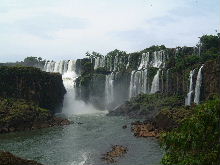 We drove on to the north. The landscape turned from endelss cattle land to tea plantations. We reached the second highlight
of our journey, the waterfalls at Iguazú National Park. Iguazú means "great water" in Guaraní. Shortly before flowing into the
Paraná at the border with Brazil and Paraguay the Iguazú River falls up to 75 m in two steps in several cascades with a
total length of 2.5 km. Even as the river had less water than normal because it had rained little the sight was
overwhelming. Of course there were a lot of people here but everything was very well organized.
We drove on to the north. The landscape turned from endelss cattle land to tea plantations. We reached the second highlight
of our journey, the waterfalls at Iguazú National Park. Iguazú means "great water" in Guaraní. Shortly before flowing into the
Paraná at the border with Brazil and Paraguay the Iguazú River falls up to 75 m in two steps in several cascades with a
total length of 2.5 km. Even as the river had less water than normal because it had rained little the sight was
overwhelming. Of course there were a lot of people here but everything was very well organized.
Then we drove along the Paraná River, a mighty stream, and the border to Paraguay through the province of Misiones. Near
the city of Posadas we visited some of the jesuitic missions which were settlements where the Spaniards tried to settle
down the Indian population and control them. Only ruins are left over.
We went on to the town of Ituzaingó on the Paraná and the enormous dam of Yacyretá. Paraná means "like the sea" in Guaraní.
As of now 2.100 MW of electrical power are generated in 20 turbines. After expansion of the dam the production is planned to
increase to 3.200 MW, enough to cover 15 % of the Argentinian demand. With 13.000 m3/h
the Paraná has a greater flow at this site than at the dam of Itaipú but the water height is with presently 18 m
(later 23 m) much lower so only a fifth of the electrical current can be produced.
 On our way to the provincial capital of Corrientes we entered the town of Itatí. There we discovered a huge basilica in
which the Virgin Mary is venerated. Once in Corrientes we installed ourselves at the hotel and explored the city.
Corrientes emanates a special flair with all its ancient buildings in different styles. At the evening everybody seemed
to be jogging at the waterfornt street, the Costanera, or enjoying the night.
On our way to the provincial capital of Corrientes we entered the town of Itatí. There we discovered a huge basilica in
which the Virgin Mary is venerated. Once in Corrientes we installed ourselves at the hotel and explored the city.
Corrientes emanates a special flair with all its ancient buildings in different styles. At the evening everybody seemed
to be jogging at the waterfornt street, the Costanera, or enjoying the night.
The next day we wanted to go on early. After breakfast we packed our things into the car and went off. As we arrived at
the bridge above the Paraná it was closed by the military. After several hours somebody told us that demonstrators had
cut the way. Days later we saw on TV that those were fishermen who were protesting government regulations on the opening
of mesh of the nets so that younger fish could escape and the depleted population recover. After we had to wait up to
17:30 hrs and the day was lost I could not feel sympathetic at all for the fishermen. It puzzled me how the police and the
miliary would allow this blockade that paralyzed traffic between two million-habitant cities (the capitals Corrientes
and Resistencia).
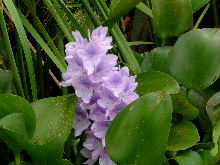 Once over the Paraná we first went to Chaco National Park. There there were so many mosquitoes that we fled. Then we
went on north to the city of Formosa and to Río Pilcomayo National Park. The park ranger told us that often caimans
were laying on the board walk. And so it was. There was one trying to cool off its body. Again there was no soul
around.
Once over the Paraná we first went to Chaco National Park. There there were so many mosquitoes that we fled. Then we
went on north to the city of Formosa and to Río Pilcomayo National Park. The park ranger told us that often caimans
were laying on the board walk. And so it was. There was one trying to cool off its body. Again there was no soul
around.
Originally we had planned to drive alnog the border to the city of Jujuy but the highway was partly dirt so we decided
to turn south. We stopped at the city of Reconquista which ist not famous but has a beautiful church that looks very
Italian. It was weekend and we asked if there was some place for dancing tango. But in the north nobody is interested
in tango. Here is Chamamé country, a music style with Paraguayan influence. Also we watched an event at the Syrian-Lebanese
Association celebrating Independence Day of Lebanon. Argentina is a country of immigrants with a very small percentage
of indigenous people. Many persons looked so German that it seemed ridiculous to adress them in Spanish. And then it was
weird to hear them answer in Argentinian Spanish. If one listens carefully one can notice the Italian influence on the
language which is also hearable in the melody. Jorge Luis Borges, a famous Argentinian writer, said that Argentinians
were Italians who spoke Spanish and wanted to be Englishmen. He was not wrong.
 Then we went on to the capital of Santa Fé which is also along the Paraná. On the other side of the river is the capital
of the province of Paraná which has the same name. Both cities have beautiful downtowns with colonial buildings. After that we
went on to Rosario. Here is the enormous Monument to the Flag. As a passionate people Argentinians, as most Latin Americans,
are very patriotic. They are also very religious as the many effigies of the Lady of Luján, which are everywhere, testify.
And they tend to build up a cult of certain personalities as is the case with Gauchito Gil, Eva Perón an recently Diego Maradona.
Then we went on to the capital of Santa Fé which is also along the Paraná. On the other side of the river is the capital
of the province of Paraná which has the same name. Both cities have beautiful downtowns with colonial buildings. After that we
went on to Rosario. Here is the enormous Monument to the Flag. As a passionate people Argentinians, as most Latin Americans,
are very patriotic. They are also very religious as the many effigies of the Lady of Luján, which are everywhere, testify.
And they tend to build up a cult of certain personalities as is the case with Gauchito Gil, Eva Perón an recently Diego Maradona.
 After a short stop in San Antonio de Areco, a beautiful small town where gaucho culture is fostered, we went on to Luján
were the patron of Argentina, the Lady of Luján, is venerated. The basilica is new but nevertheless beautiful. The trip
went on via Tandil to the ressort of Mar del Plata, the best known of Argentina. In summer (January and Februarry) there
is a lot of people here. The sea is not exactly the Caribbean but the beach is very nice. In the evening we went to the
port were the fishermen were arriving to load off their catch. They were escorted by sea lions which ate the refused fish
and rested on the docks. It was a marvelous experience. But I shuddered when we passed the memorial for those fishermen
that never returned from the sea. Here it again became clear to me how hard many people must work to earn their lives.
After a short stop in San Antonio de Areco, a beautiful small town where gaucho culture is fostered, we went on to Luján
were the patron of Argentina, the Lady of Luján, is venerated. The basilica is new but nevertheless beautiful. The trip
went on via Tandil to the ressort of Mar del Plata, the best known of Argentina. In summer (January and Februarry) there
is a lot of people here. The sea is not exactly the Caribbean but the beach is very nice. In the evening we went to the
port were the fishermen were arriving to load off their catch. They were escorted by sea lions which ate the refused fish
and rested on the docks. It was a marvelous experience. But I shuddered when we passed the memorial for those fishermen
that never returned from the sea. Here it again became clear to me how hard many people must work to earn their lives.
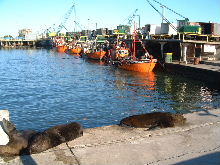 Afterwards we drove along the coast toward Buenos Aires and stopped at the province capital La Plata. This young city is
also very nice and has a huge cathedral that resembles the cathedral of Cologne mixed with a renaissance style. Everywhere
ther are lots of trees, sometimes too many.
Afterwards we drove along the coast toward Buenos Aires and stopped at the province capital La Plata. This young city is
also very nice and has a huge cathedral that resembles the cathedral of Cologne mixed with a renaissance style. Everywhere
ther are lots of trees, sometimes too many.
Finally we arrived back at Buenos Aires where we returned the car. On the last evening we strolled through Puerto Madero
and through San Telmo with its many street cafés. Between the hotel and San Telmo we had to cross the freeway under a
bridge. There we saw the other side of Argentina. Three men were sorting garbage. One of them found a piece of bread and
sniffed at it to see if it was still eatable. Somehow I felt guilty.
It was again a beautiful journey. We realized Argentinians are much better than their reputation among Latin Americans.
Everywhere, especially on the countryside, people where very cordial. One gets frequently involved in long conversations as
though speaking with long known friends. There prevails an ordered chaos. Driving is an adventure but somehow everything
goes right. You don't drive on the track but on the line. A clear regulation of the right of way is non existing. The one
who bumps must pay, no matter if he had to yield or not (isn't that very logical?). And somehow it is not Latin America
but Europe - the people, the buildings, the cars. One thing is certain: We want to come back and visit all other parts
of this huge and beautiful country.
|
|

